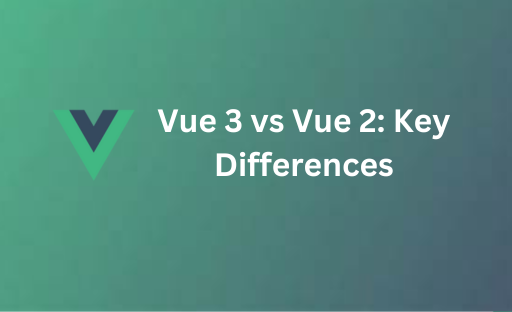Explore the key differences between Vue 3 vs Vue 2, including major improvements like the Composition API, enhanced reactivity system, TypeScript support, and performance optimizations. Learn how to migrate from Vue 2 to Vue 3 with ease.
Vue.js, one of the most popular JavaScript frameworks for building dynamic user interfaces, introduced Vue 3 in September 2020. This new version comes with several improvements and changes that enhance its performance, usability, and scalability. While Vue 2 was a revolutionary tool for developers, Vue 3 takes things to the next level with its Composition API, enhanced reactivity system, and optimized rendering engine. In this blog, I will dive into the key differences between Vue 3 vs Vue 2, discuss the migration process, and answer some commonly asked interview questions.
Table of Contents
1. Major Improvements in Vue 3
Vue 3 introduces several changes and enhancements over Vue 2, designed to meet modern web development challenges. Here’s an overview of the major improvements:
1.1. Composition API
Vue 3 introduces the Composition API, which is a function-based approach for structuring component logic. It allows developers to write cleaner, more modular, and reusable code.
Vue 2: Options API
export default {
data() {
return {
count: 0,
};
},
methods: {
increment() {
this.count++;
},
},
};
Vue 3: Composition API
import { ref } from "vue";
export default {
setup() {
const count = ref(0);
const increment = () => count.value++;
return { count, increment };
},
};
Benefits:
- Improves code organization, especially in large applications.
- Enhances reusability through composable functions.
- Fully compatible with TypeScript.
1.2. Improved Reactivity System
The reactivity system in Vue 3 is now based on ES6 proxies, replacing the Object.defineProperty() mechanism used in Vue 2. This change enables better performance and allows developers to handle more complex data structures.
Key Advantages:
- Deep reactivity for nested objects.
- Improved performance for large-scale applications.
- Easier debugging with proxy-based reactivity.
Example: Vue 3 Reactivity
import { reactive } from "vue";
const state = reactive({
user: {
name: "Aishw",
age: 25,
},
});
state.user.age++;
console.log(state.user.age); // 26
1.3. Smaller Bundle Size
Vue 3 is more modular and tree-shakable, leading to smaller production builds. This results in faster loading times and better performance for end-users.
1.4. TypeScript Support
Vue 3 is built with TypeScript, ensuring better type safety and easier integration with TypeScript-based projects.
1.5. Fragment and Teleport
- Fragments: Allows components to return multiple root nodes, simplifying the structure of templates.
- Teleport: Enables rendering elements outside of the Vue app’s root DOM node.
1.6. Enhanced Performance
- Up to 55% faster rendering compared to Vue 2.
- Optimized memory usage.
- Improved tree-shaking for unused features.
2. Migration from Vue 2 to Vue 3
Migrating from Vue 2 to Vue 3 can be done gradually, thanks to Vue’s backward compatibility and the official migration build. Here’s a step-by-step guide:
2.1. Upgrade Dependencies
Ensure you have updated versions of all dependencies compatible with Vue 3.
npm install vue@3
2.2. Refactor Code
Start by refactoring smaller components to use the Composition API and other Vue 3 features. Use the Vue Migration Build to identify compatibility issues.
2.3. Use Vue CLI
If you’re starting a new project, use the Vue CLI to create a Vue 3-based project.
vue create my-vue3-app
2.4. Address Breaking Changes Vue 2 vs Vue 3
Refer to the Migration Guide for breaking changes such as:
- Custom directives (
v-modelsyntax). - Filters (deprecated in Vue 3).
- Changes in lifecycle hooks (e.g.,
beforeDestroy→onUnmounted).
2.5. Example: Refactoring a Component
Vue 2 Component:
export default {
data() {
return {
message: "Hello Vue 2!",
};
},
};
Vue 3 Component:
import { ref } from "vue";
export default {
setup() {
const message = ref("Hello Vue 3!");
return { message };
},
};

Top 10 Vue 2 vs Vue 3 Interview Questions and Answers
1. What are the key differences between Vue 2 vs Vue 3?
Answer:
- Vue 3 introduces the Composition API for better logic reusability.
- Vue 3 uses ES6 proxies for a more efficient reactivity system.
- TypeScript support is built into Vue 3.
- Smaller bundle size and improved performance in Vue 3.
2. What is the Composition API, and how is it different from the Options API?
Answer: The Composition API is a function-based approach for structuring component logic, whereas the Options API organizes logic in separate sections like data, methods, and computed. The Composition API allows for better code modularity and reusability.
3. How does Vue 3 improve the reactivity system?
Answer: Vue 3’s reactivity system is based on ES6 proxies, which enables better performance and deep reactivity for nested objects. It also simplifies the handling of dynamic properties.
4. How can you migrate a Vue 2 application to Vue 3?
Answer:
- Upgrade dependencies.
- Refactor components using the Composition API.
- Address breaking changes using the migration guide.
- Test and deploy the Vue 3 application.
5. What are Fragments in Vue 3?
Answer: Fragments allow components to return multiple root nodes, removing the requirement for a single root node.
6. What is Teleport in Vue 3?
Answer: Teleport enables rendering DOM elements outside the Vue app’s root DOM node, useful for modals and tooltips.
7. What are the lifecycle hooks in Vue 3?
Answer: Lifecycle hooks in Vue 3 include:
onMounted(): Called after the component is mounted.onUpdated(): Called after the component is updated.onUnmounted(): Called after the component is destroyed.
8. What is the Migration Build in Vue 3?
Answer: The Migration Build provides warnings for compatibility issues between Vue 2 vs Vue 3, helping developers migrate incrementally.
9. What are the benefits of TypeScript in Vue 3?
Answer:
- Type safety for props, emits, and data.
- Easier debugging.
- Better integration with modern development tools.
10. How does Vue 3 handle tree-shaking?
Answer: Vue 3 is designed to be fully tree-shakable, meaning unused features are excluded from the production build, reducing bundle size.
Conclusion
Vue 3 is a significant evolution of Vue.js, offering better performance, scalability, and developer experience. Its Composition API, improved reactivity system, and TypeScript support make it a powerful tool for building modern web applications. Migrating to Vue 3 might seem challenging initially, but with the right approach and tools, you can harness the full potential of this framework.

